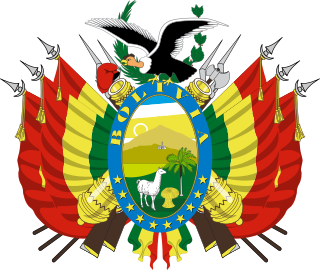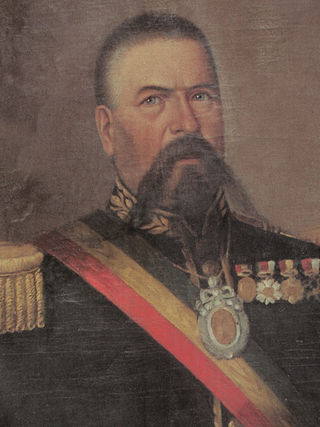
José Miguel de Velasco Franco was a Bolivian military officer and statesman who served as the fourth president of Bolivia on four occasions: 1828, 1829, 1839–1841, and 1848. Velasco also served as the second vice president from 1829 to 1835 under Andrés de Santa Cruz, though the first two of his terms were as vice president-designate, pending Santa Cruz's arrival to the country.

Council of Ministers of Bolivia, or Cabinet of Bolivia, is part of the executive branch of the Bolivian government, consisting of the heads of the variable number of government ministries. The Council of Ministers are ministers of state and conduct the day-to-day business of public administration within Bolivia. The President of Bolivia may freely reorganize the executive branch, with the most recent comprehensive reorganization occurring in February 2009. Since then, the Ministry for the Legal Defense of the State has become the independent office of Solicitor General, and the Ministry of Communication has been created.

The Ministry of Cultures, Decolonization, and Depatriarchalization is the ministry of the government of Bolivia that provides for the preservation and protection of the cultures and artistic expressions of the indigenous peoples of Bolivia as well as promotes the country's tourism sector and process of decolonization and depatriarchalization.
The Ministry of Government is a ministry of the Plurinational States of Bolivia. It is tasked with regulating public policy. The current Minister of Government is Eduardo del Castillo since 9 November 2020.

Luis Paz Arce was a Bolivian historian, journalist, jurist, lawyer, and politician who served on the Supreme Court of Justice of Bolivia for twenty-three years, an associate justice from 1905 to 1919 and as the president from 1919 until his death in 1928. A conservative, Paz held a lengthy political and academic background, serving in various legislative and ministerial positions from the early 1880s to the mid-1890s, including as minister of war from 1895 to 1896, minister of government from 1892 to 1895, and senator for Tarija from 1892 to 1898. In 1921, the National Convention selected him to be vice president under Bautista Saavedra, but he rejected the position, preferring to remain on the High Court.

The Velasco III Cabinet constituted the 10th and 11th cabinets of the Bolivian Republic. It was formed on 27 March 1839, thirty-three days after José Miguel de Velasco was reinstalled as the 4th president of Bolivia following a coup d'état, succeeding the Santa Cruz Cabinet. It was dissolved on 10 June 1841 upon Velasco's overthrow in another coup d'état and was succeeded by the Cabinet of José Ballivián.

The Ballivián Cabinet, which comprised the 12th to 14th cabinets of the Bolivian Republic, came into being on October 18, 1841. This was 21 days after José Ballivián assumed office as the 9th president of Bolivia, following a coup d'état that saw him take over from the Third Velasco Cabinet. The cabinet continued to serve until December 23, 1847, when Ballivián resigned from office, and it was subsequently dissolved. Cabinet of Eusebio Guilarte succeeded the Ballivián Cabinet.

The Velasco IV Cabinet constituted the 16th cabinet of the Bolivian Republic. It was formed on 4 February 1848, 17 days after José Miguel de Velasco was reinstalled) as the 4th president of Bolivia following a coup d'état, succeeding the Guilarte Cabinet. It was dissolved on 16 October 1848 when acting president José María Linares merged all ministerial portfolios into a singular General Secretariat and was succeeded by the Cabinet of Manuel Isidoro Belzu.

The Belzu Cabinet constituted the 17th to 22nd cabinets of the Bolivian Republic. It was formed on 10 February 1849, 66 days after Manuel Isidoro Belzu was installed as the 11th president of Bolivia following a coup d'état, succeeding the Fourth Velasco Cabinet. It was dissolved on 15 August 1855 upon the end of Belzu's term and was succeeded by the Cabinet of Jorge Córdova.

The Córdova Cabinet constituted the 23rd cabinet of the Bolivian Republic. It was formed on 17 August 1855, 2 days after Jorge Córdova was sworn-in as the 12th president of Bolivia following the 1855 general election, succeeding the Belzu Cabinet. It was dissolved on 9 September 1857 upon Córdova's overthrow in a coup d'état and was succeeded by the Cabinet of José María Linares.

The Linares Cabinet constituted the 24th cabinet of the Bolivian Republic. It was formed on 9 December 1857, 91 days after José María Linares was installed as the 13th president of Bolivia following a coup d'état, succeeding the Córdova Cabinet. It was dissolved on 14 January 1861 upon Linares' overthrow in another coup d'état and was succeeded by a Government Junta.

The Achá Cabinet constituted the 26th to 29th cabinets of the Bolivian Republic. It was formed on 17 May 1861, 13 days after José María de Achá was sworn-in as the 14th president of Bolivia following his election by the Constituent National Assembly, succeeding the Government Junta. It was dissolved on 28 December 1864 upon Achá's overthrow in a coup d'état and was succeeded by the Cabinet of Mariano Melgarejo.

The Melgarejo Cabinet constituted the 30th cabinet of the Republic of Bolivia. It was formed on 19 June 1867 after Mariano Melgarejo was installed as the 15th president of Bolivia following the coup d'état, succeeding the Achá Cabinet. It was dissolved on 15 January 1871 upon Melgarejo's overthrow in another coup d'état and was succeeded by the Cabinet of Agustín Morales.

The Morales Cabinet constituted the 31st to 32nd cabinets of the Republic of Bolivia. It was formed on 22 June 1871 after Agustín Morales took power in a coup d'état, succeeding the Melgarejo cabinet. It was dissolved on 27 November 1872 when Morales was assassinated. All Ministers of State were ratified in their positions by the new cabinet formed by Morales' successor Tomás Frías.

The Frías I Cabinet constituted the 33rd cabinet of the Republic of Bolivia. It was formed on 28 November 1872 after Tomás Frías was sworn in as the 17th president of Bolivia following the assassination of Agustín Morales, succeeding the Morales Cabinet. It was dissolved on 9 May 1873 upon the end of Frías' mandate and was succeeded by the Cabinet of Adolfo Ballivián.

The Ballivián Cabinet constituted the 34th cabinet of the Republic of Bolivia. It was formed on 9 May 1873 after Adolfo Ballivián was sworn in as the 18th president of Bolivia following the 1873 general election, succeeding the First Frías Cabinet. It was dissolved on 14 February 1874 upon Ballivián's death and was succeeded by the Cabinet of Tomás Frías II.

The Frías II Cabinet constituted the 35th cabinet of the Republic of Bolivia. It was formed on 14 February 1874 after Tomás Frías was sworn in as the 17th president of Bolivia following the death of Adolfo Ballivián, succeeding the Ballivián Cabinet. It was dissolved on 4 May 1876 upon Frías' overthrow in a coup d'état and was succeeded by the Cabinet of Hilarión Daza.

The Daza cabinet constituted the 36th to 37th cabinets of the Republic of Bolivia. It was formed on 28 October 1876, four months after Hilarión Daza was installed) as the 19th president of Bolivia following a coup d'état, succeeding the Frías cabinet. It was dissolved on 28 December 1879 upon Daza's overthrow in another coup d'état and was succeeded by the Cabinet of Narciso Campero.

















